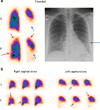V/P SPECT as a diagnostic tool for pregnant women with suspected pulmonary embolism
- PMID: 25916742
- PMCID: PMC4480826
- DOI: 10.1007/s00259-015-3056-z
V/P SPECT as a diagnostic tool for pregnant women with suspected pulmonary embolism
Abstract
Purpose: The purpose of the study was to assess the prevalence of pulmonary embolism (PE) and other lung diseases among pregnant women with suspected PE and to calculate the radiation exposure to patient and fetus in this population. As a secondary aim, we evaluated the negative predictive value of a normal ventilation/perfusion single photon emission computed tomography (V/P SPECT) examination in pregnancy.
Methods: We studied all 127 pregnant women who had suspected PE and had undergone V/P SPECT at our institution in the course of a 5-year period. Radiation exposure to patient and fetus and the negative predictive value of a normal V/P SPECT examination were also measured.
Results: V/P SPECT identified PE in 11 women (9%). Moreover, in 15 women (12%) the examination revealed pneumonia (in 2 cases in addition to PE) and in 1 woman signs of airway obstruction were revealed. Among the 116/127 women (91%) where PE was ruled out by V/P SPECT, none was diagnosed subsequently with PE or deep venous thrombosis (DVT) during the same pregnancy or puerperal period. For P SPECT, the calculated fetal absorbed dose was < 0.6 mGy,and the calculated breast absorbed dose 0.6 mGy. For V SPECT, the calculated fetal absorbed dose was < 0.014 mGy and the breast absorbed dose 0.25 mGy.
Conclusion: The prevalence of PE was low (9%) among pregnant women with suspected disease. Pneumonia was diagnosed in 12% of patients. The negative predictive value of V/P SPECT was high, and the radiation exposure from V/P SPECT was low both for fetus and patient.
Figures

References
-
- Virkus RA, Løkkegaard EC, Lidegaard Ø, Langhoff-Roos J, Bjerregaard L, Skovlund CW, et al. Venous thromboembolism in pregnancy and the puerperal period: a study of 1210 events. Acta Obstet Gynecol Scand. 2013;92(10):1135–1142. - PubMed
-
- Sivandarajah S. Towards evidence-based emergency medicine: best BETs from the Manchester Royal Infirmary. BET 4: current evidence does not support the use of a negative D-dimer to rule out suspected pulmonary embolism in pregnancy. Emerg Med J. 2011;28(3):245–246. doi: 10.1136/emj.2011.111617. - DOI - PubMed
Publication types
MeSH terms
Substances
LinkOut - more resources
Full Text Sources
Other Literature Sources
Medical
Research Materials

